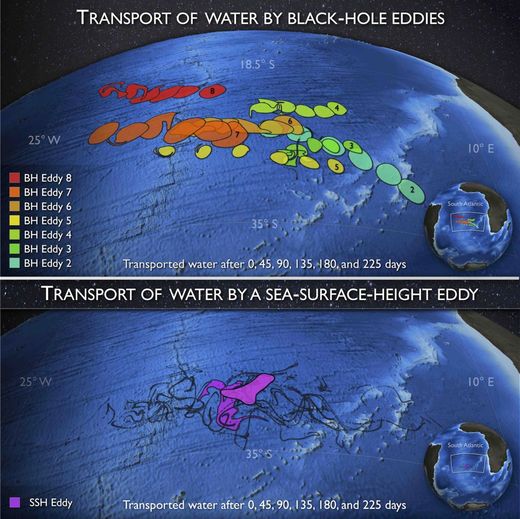| Topic: Ultra-powerful "black hole" whirlpools seen for the first ti | |
|---|---|
|
Edited by
mightymoe
on
Thu 08/22/13 09:34 AM
|
|
|
Chris Hall
Yahoo! News Wed, 21 Aug 2013 04:40 CDT 
Two mysterious 'black hole' whirlpools have been spotted in the South Atlantic ocean Satellites have shown two mysterious 'black hole' whirlpools in the South Atlantic ocean - ultra powerful "vortexes" which suck water down into the depths. The whirpools - never witnessed before - would suck down ships, debris and even living creatures, moving 1.3 million cubic metres of water per second. Two of the black holes - or "maelstroms" - have been sighted in three months by physicists from Zurich and Miami. The powerful vortices of current have been described as 'maelstroms' and are 'mathematical analogues' for black holes - which is to say they do exactly the same with water that black holes do with light. 
Top panel: Evolution of black-hole eddies (extracted from 3 months of data) in the South Atlantic over a period of 225 days. The eddies move from east to northwest (form right to left). Bottom panel: Material evolution of a nonlinear SSH eddy over the same 225 days. The discovery could give new insights into how oceanic currents transport debris and may even have implications for climate change studies. Astronomical black holes bend space and time into a perpetually collapsing vortex. Light itself bends around them, which enables astronomers to recognise their existence. Similarly, these oceanic maelstroms funnel current into an almost permanent spiral, trapping debris, oil and potentially living creatures in a body of water. Hardly anything leaks out. The scientists used Edgar Allen Poe's 1841 story 'A descent into a Maelstrom' to describe their discovery: "The edge of the whirl was represented by a broad belt of gleaming spray; but no particle of this slipped into the mouth of the terrific funnel..." The ability to apply the same mathematical principles to water currents on earth as black holes in space is an unexpected side-effect of the theory of general relativity. This phenomenon has been observed in the South Atlantic and South-western Indian Ocean, using satellite imagery designed to spot the aquatic equivalent of black hole currents. According to scientists, the maelstroms are prevalent in this area thanks to the southbound Agulhas current in the Indian Ocean. In a three-month period, two perfect matches were found to mimic black hole behaviour, "We have found exceptionally coherent material belts in the South Atlantic, filled with analogues of photon spheres around black holes," said George Haller, from the Swiss Federal Institute of Technology in Zürich and Francisco Beron-Vera at the University of Miami in Florida, who worked on the study. The phrase 'photon spheres' refers to the light that is trapped around astronomical black holes, and in this instance is comparable to the rings of debris that are forming around these ocean maelstroms. As Haller and Beron-Vera's findings note, 'these vortices will capture and swallow nearby passively floating debris.' In their research findings, Haller and Beron-Vora express their surprise at finding real-world examples that hold so closely to the theoretical equations. 'Vortices in turbulence are often envisaged as rotating bodies of fluid, traveling as coherent islands in an otherwise incoherent ambient flow. This... ...view is appealingly simple, yet challenging to apply in actual vortex detection.' The maelstroms are detected by their rotating edges, which the scientists found were reliable indicators of the vortex within, based on pioneering research carried out by Stephen Hawking on black holes: 'Intuitively, one expects that any...vortex in the fluid must contain such a singularity in its interior, just as all black holes are expected to contain Penrose-Hawking singularities. This expectation turns out to be correct'. The singularities, as they have been termed, last for months at a time, moving across the ocean without interference from other currents. Thus they can transport water of different temperatures and salinity to other areas of the ocean, potentially influencing the regional climate. Haller and Beron-Vera found that the vortices transported water in a north-western direction 30% faster than had previously been reckoned - at a rate equating to 1.3 million cubic metres of water per second. In addition, the maelstroms were found to occur four times deeper in the ocean than previously estimated; the study found examples as deep as 2000m below the surface. |
|
|
|
|
|
Wow! That is amazing!
|
|
|
|
|
|
That's incredible.
|
|
|
|
|
|
i was talking with a friend about a "fluid universe", this seems to fit in...lol
|
|
|
|
|
|
Thanks for that shared info. Very interesting. Wonder how i haven't heard of that until now .... hmmmm.
|
|
|
|
|









